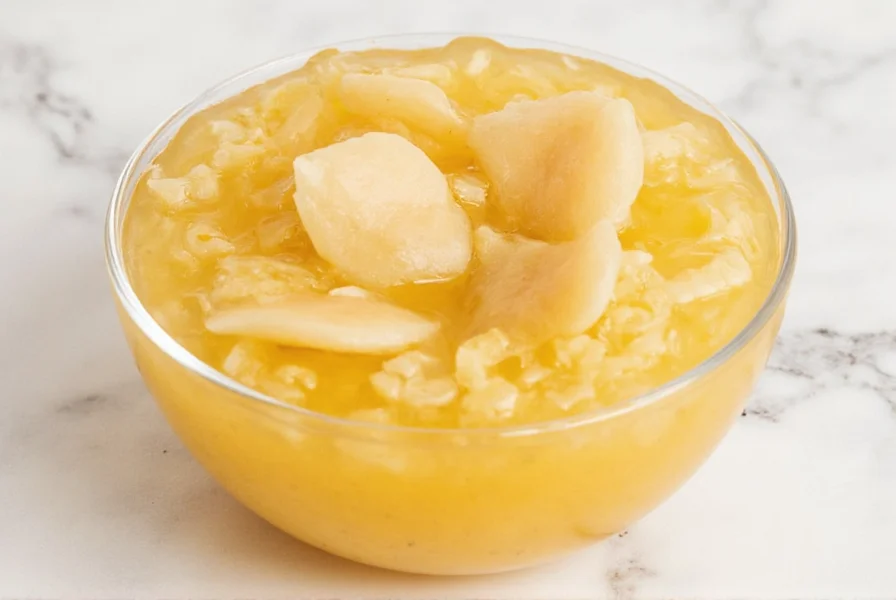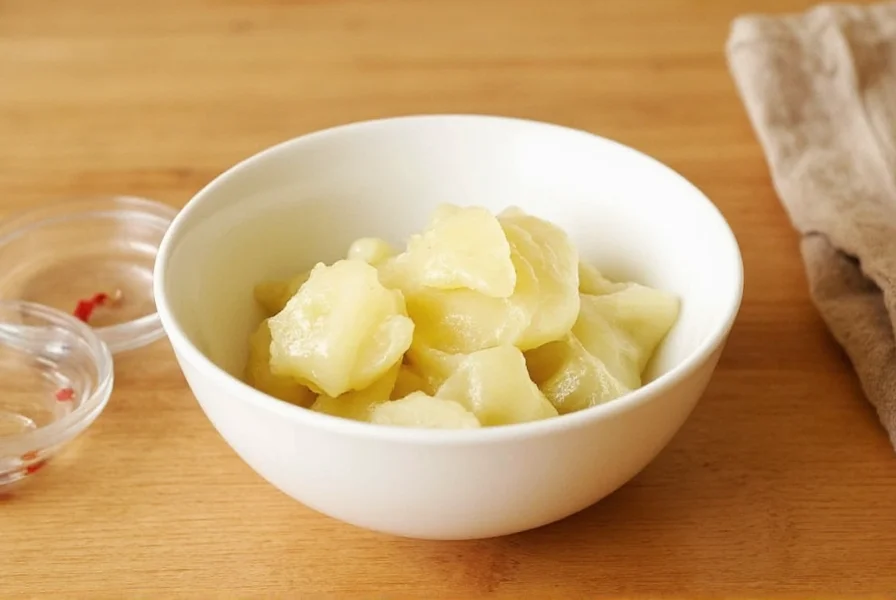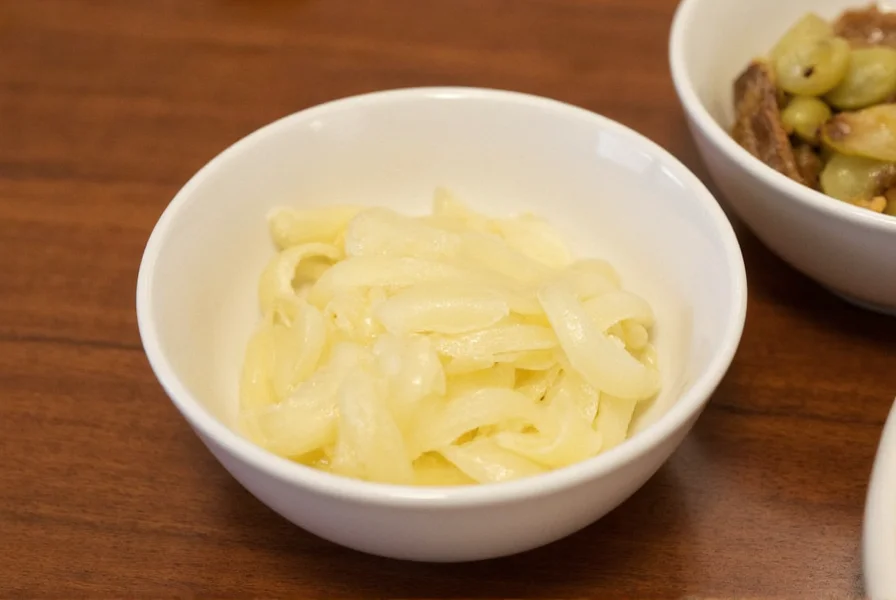When exploring Japanese cuisine, few accompaniments are as distinctive yet understated as Japanese pickled ginger. Unlike Western-style pickled ginger which tends to be spicier and darker, authentic Japanese preparation creates a delicate condiment that enhances rather than overwhelms delicate sushi and sashimi flavors. The transformation from raw ginger root to the translucent pink slices served in sushi restaurants involves specific techniques perfected over generations.
Understanding Gari: Japan's Signature Pickled Ginger
The term gari specifically refers to the sweet, thinly sliced pickled ginger commonly served with sushi. This differs from beni shoga, another Japanese pickled ginger preparation that uses red shiso vinegar for a brighter color and stronger flavor, typically accompanying dishes like yakisoba or tonkatsu.
What makes Japanese pickled ginger unique is its careful preparation process. Chefs select young ginger (shin shoga) harvested in early summer when the skin remains thin and the flesh exceptionally tender. This young ginger contains less fiber than mature roots, yielding the characteristic crisp-yet-delicate texture that defines quality gari.

Traditional Preparation Methods
Authentic Japanese pickled ginger preparation follows precise steps that balance flavor, texture, and appearance:
- Selection: Choose young ginger with smooth, pale skin and minimal fibrousness
- Slicing: Cut extremely thin slices (approximately 1-2mm thick) across the grain
- Soaking: Briefly soak in vinegar to reduce sharpness while preserving crispness
- Marinating: Combine with sweet rice vinegar, sugar, and sometimes a touch of salt
- Pink hue development: Natural reaction between young ginger's enzymes and vinegar creates the characteristic pale pink color
Many commercial producers add food coloring to achieve consistent pinkness, but traditional preparation relies on the natural color transformation that occurs during the initial pickling phase. The pink hue typically appears within 24-48 hours as the ginger's anthocyanins react with the acidic vinegar solution.
Culinary Applications Beyond Sushi
While most Western diners associate Japanese pickled ginger exclusively with sushi, its culinary applications extend throughout Japanese cuisine:
- As a palate cleanser between different fish varieties during omakase service
- As a garnish for rice bowls (donburi) to add brightness
- Chopped finely and mixed into dipping sauces for added dimension
- Served alongside grilled fish to cut through richness
- Used as a colorful accent in bento boxes
The subtle sweetness and mild ginger flavor make it particularly suitable for enhancing delicate dishes without overpowering them—a principle central to Japanese culinary philosophy.
Regional Variations and Quality Indicators
Different regions of Japan have developed distinctive approaches to preparing pickled ginger:
| Region | Preparation Style | Distinctive Characteristics |
|---|---|---|
| Hokkaido | Longer vinegar soak | Milder flavor, softer texture |
| Kyoto | Higher sugar ratio | Sweeter profile, brighter pink |
| Tokyo | Balanced sweet-tart ratio | Crisp texture, traditional appearance |
When evaluating quality Japanese pickled ginger, look for these characteristics:
- Translucent, uniformly pale pink color (avoid bright pink which suggests artificial coloring)
- Crisp but tender texture that yields slightly when pressed
- Delicate balance of sweet and tangy flavors without vinegar harshness
- Subtle ginger aroma without medicinal or overly spicy notes
- Thin, consistent slicing that demonstrates preparation care
Storage and Shelf Life Considerations
Proper storage significantly impacts the quality and longevity of Japanese pickled ginger:
- Refrigerate at all times after opening (32-38°F / 0-3°C)
- Store submerged in its pickling liquid to maintain texture
- Use clean utensils to prevent contamination
- Consume within 2-3 weeks for optimal flavor and texture
- Discard if liquid becomes cloudy or ginger develops off odors
Commercially prepared gari often contains preservatives that extend shelf life to several months when unopened, but homemade versions typically last 2-3 weeks under proper refrigeration. The flavor profile gradually intensifies over time as the ginger fully absorbs the pickling solution.

Health Aspects of Japanese Pickled Ginger
While not a substitute for medical treatment, Japanese pickled ginger offers several potential wellness benefits supported by nutritional science:
- Contains gingerol compounds with antioxidant properties
- May support digestive health when consumed in moderation
- Provides a low-calorie flavor enhancement alternative to salt
- Serves as a natural breath freshener after meals
- Contains small amounts of potassium and magnesium
The pickling process preserves many of ginger's beneficial compounds while mellowing its sharper qualities. Unlike raw ginger which can be quite pungent, the pickled version offers a gentler introduction to ginger's properties, making it more accessible for those sensitive to strong flavors.
Selecting Quality Japanese Pickled Ginger
When purchasing Japanese pickled ginger, consider these factors to ensure authenticity and quality:
- Check ingredient lists for minimal components (ginger, rice vinegar, sugar)
- Avoid products listing artificial colors or preservatives as primary ingredients
- Look for "shin shoga" or "young ginger" on packaging when available
- Examine texture in the jar—slices should appear intact and translucent
- Reputable Japanese grocery stores typically offer higher quality options
For those interested in homemade preparation, authentic Japanese pickled ginger requires minimal ingredients but precise technique. The traditional ratio of one part sugar to two parts rice vinegar creates the characteristic sweet-tart profile that complements sushi without overwhelming it.
What is the difference between gari and beni shoga?
Gari is thinly sliced young ginger pickled in sweet rice vinegar, typically pale pink and served with sushi as a palate cleanser. Beni shoga uses mature ginger pickled with red shiso vinegar, resulting in bright red color and stronger flavor, commonly used with dishes like yakisoba or tonkatsu.
Why is Japanese pickled ginger pink?
The pale pink color in authentic Japanese pickled ginger develops naturally when young ginger's enzymes react with the acidic vinegar solution. This occurs during the initial pickling phase (24-48 hours). Many commercial products add food coloring for consistent appearance, but traditional preparation relies on this natural color transformation.
How long does homemade Japanese pickled ginger last?
Properly prepared and stored in airtight containers submerged in their pickling liquid, homemade Japanese pickled ginger typically maintains optimal quality for 2-3 weeks in the refrigerator. The flavor continues developing during this time, reaching peak balance around 10-14 days after preparation.
Can I use regular vinegar instead of rice vinegar for Japanese pickled ginger?
While possible, substituting regular vinegar significantly alters the flavor profile. Authentic Japanese pickled ginger relies on rice vinegar's mild acidity and subtle sweetness. Apple cider vinegar makes an acceptable alternative, but distilled white vinegar creates an overly harsh flavor that overwhelms the delicate ginger notes essential to traditional gari.
What makes Japanese pickled ginger different from Western-style?
Japanese pickled ginger (gari) uses young ginger with a sweet rice vinegar brine, resulting in thin, pale pink slices with mild flavor. Western-style pickled ginger typically uses mature ginger with stronger vinegar and less sugar, creating thicker, darker slices with more pronounced heat and tanginess, often served as a standalone condiment rather than a palate cleanser.











 浙公网安备
33010002000092号
浙公网安备
33010002000092号 浙B2-20120091-4
浙B2-20120091-4